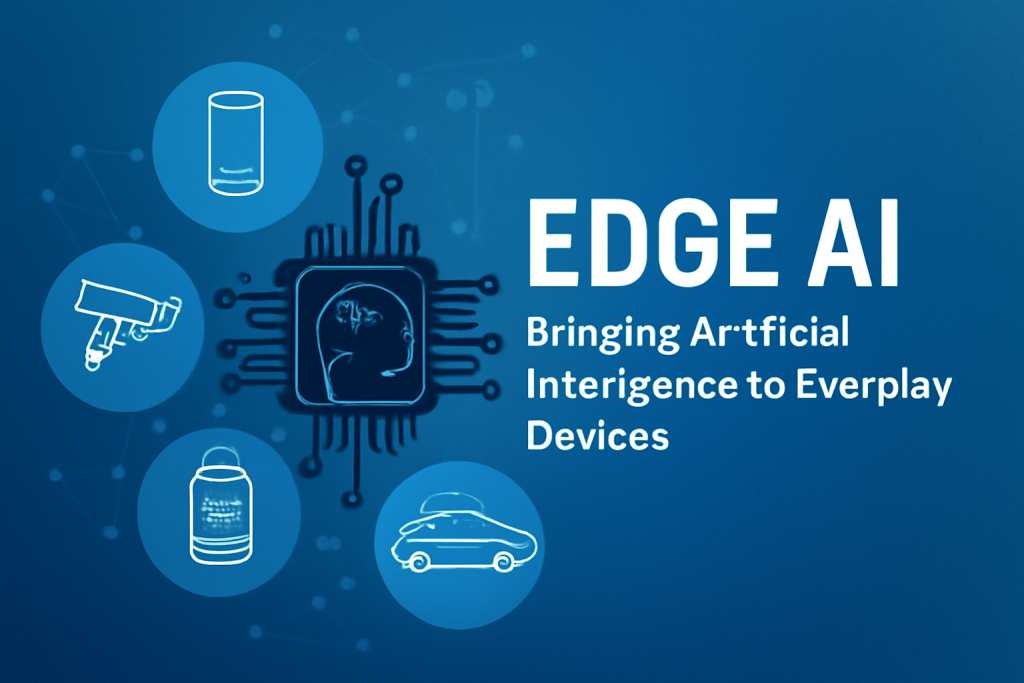
Introduction: The Intersection of AI and Everyday Devices
In recent years, the convergence of artificial intelligence (AI) and edge computing has brought forth a new paradigm known as Edge AI. This revolutionary shift allows AI algorithms to process data locally on devices like smartphones, smart cameras, and even industrial machines, without relying solely on cloud infrastructure. But why is this important? As AI applications increasingly permeate every aspect of our daily lives, from healthcare to transportation, the need for real-time decision-making, low latency, and privacy-conscious solutions becomes more urgent.
The traditional AI model, which relies heavily on the cloud, has limitations in terms of speed, privacy, and bandwidth. Edge AI overcomes these challenges by enabling devices to process data at the edge of the network, closer to where it is generated. This allows AI systems to make faster decisions, with reduced data transfer costs and improved security.
In this post, we’ll dive deep into Edge AI, its functionality, applications, benefits, challenges, and its transformative role in reshaping industries.
What is Edge AI?
Edge AI refers to the integration of AI algorithms on devices that are capable of processing data locally, often in real-time, at the “edge” of the network, rather than sending it to a central server or cloud for processing. In essence, Edge AI brings computation closer to the data source, which reduces latency and increases efficiency.
Traditionally, AI models are trained in the cloud using large datasets. These models are then deployed to devices to infer new data. However, Edge AI redefines this model by shifting both training and inference closer to the devices themselves. This is made possible by advancements in hardware, including low-power processors, specialized AI accelerators, and software frameworks designed for edge devices.
Examples of Edge AI-enabled devices include:
- Smartphones: AI for facial recognition, personalized voice assistants.
- Smart cameras: Object detection and real-time video analysis.
- Autonomous vehicles: Onboard AI for real-time decision-making in driving.
- Wearables: Health monitoring and activity tracking powered by AI.
In this rapidly advancing technological landscape, Edge AI is positioned to play a pivotal role in industries ranging from consumer electronics to healthcare, autonomous vehicles, and smart cities.
How Does Edge AI Work?
To understand how Edge AI operates, it’s important to first grasp the concept of edge computing. Edge computing is a distributed computing paradigm that processes data closer to the source of generation. Rather than sending all data to a central cloud server for analysis, edge computing allows devices to process data locally.
For AI to work efficiently on the edge, the following steps are involved:
- Data Generation: Devices such as smartphones, cameras, and sensors collect data in real-time. For example, a smart camera might capture video footage of its surroundings.
- Local Data Processing: The data is processed locally on the device using pre-trained AI models. These models run directly on the device, thanks to hardware like GPUs, TPUs, and AI accelerators that support the necessary computations.
- Inference and Decision-Making: The AI model makes inferences based on the local data, making decisions such as recognizing an object or analyzing a person’s health metrics.
- Action or Communication: Depending on the outcome of the AI model’s decision, the device may take action (e.g., sending an alert) or communicate results to other systems for further processing (e.g., in a smart home ecosystem).
This localized computation and decision-making allow Edge AI to drastically reduce latency, enhance data privacy, and save on bandwidth.
Key Technologies Enabling Edge AI
Several key technological advancements have propelled Edge AI to its current state and are enabling its future growth. These include 5G networks, IoT devices, AI accelerators, and low-power processors.
1. 5G Networks and Edge AI
The deployment of 5G networks is a major enabler for Edge AI. 5G offers significantly lower latency and higher bandwidth compared to previous generations, making it ideal for real-time AI applications. For example, autonomous vehicles rely on both high-speed network connectivity and low latency for immediate decision-making based on real-time data from their sensors. In an urban setting, traffic management systems powered by Edge AI can make instantaneous decisions on traffic flow without needing to send data to the cloud for processing, thus saving time and reducing congestion.
2. Internet of Things (IoT) Devices
The Internet of Things (IoT) refers to the network of interconnected devices that can collect and exchange data. These devices—ranging from home appliances and health trackers to environmental sensors—are at the forefront of enabling Edge AI. IoT devices are responsible for generating massive volumes of real-time data, which can be processed locally by edge AI systems to make decisions and trigger actions.
For example, a smart thermostat uses Edge AI to learn and predict temperature preferences based on a user’s habits. Rather than sending all temperature data to the cloud for analysis, the thermostat processes the data locally, adjusting the home’s temperature accordingly in real-time.
3. AI Accelerators and Low-Power Processors
AI tasks, particularly deep learning, can be computationally intensive. To perform these tasks on edge devices, specialized hardware is required. AI accelerators, such as TPUs (Tensor Processing Units) and FPGAs (Field-Programmable Gate Arrays), are designed to handle AI workloads efficiently while consuming minimal power.
Similarly, low-power processors such as ARM chips and Qualcomm’s Snapdragon are tailored for mobile and embedded devices. These processors ensure that edge devices can handle demanding AI tasks like image recognition, speech processing, and natural language processing while minimizing energy consumption, making them ideal for wearable devices and IoT sensors.
Applications of Edge AI
Edge AI is rapidly transforming multiple industries by enabling faster, smarter decision-making and reducing reliance on centralized computing systems. Here are some prominent Edge AI use cases:
1. Smart Homes and Consumer Devices
Edge AI plays a critical role in the development of smart home devices. For instance, smart speakers like Amazon’s Alexa and Google Home use edge-based AI to process voice commands locally. This local processing allows for quicker responses and improved privacy, as voice data is not transmitted to the cloud.
Smart cameras use edge AI for features like real-time object recognition, facial recognition, and anomaly detection. By processing video data on-device, these cameras can trigger immediate actions, such as sending alerts when unusual activity is detected, without needing to rely on cloud servers.
2. Healthcare and Medical Devices
Edge AI is revolutionizing healthcare by enabling real-time diagnostics and patient monitoring. Wearables, such as smartwatches and fitness trackers, use edge-based AI to monitor heart rates, detect irregular patterns, and alert users of potential health issues.
AI-powered medical devices like blood pressure monitors and glucose meters can use edge AI to analyze data on the device itself, providing immediate feedback to doctors or patients, which is essential in critical care scenarios.
3. Autonomous Vehicles
In autonomous vehicles, Edge AI enables vehicles to process sensor data from cameras, LiDAR, and radar in real-time, allowing them to make immediate decisions like steering, braking, and speed adjustments without needing to communicate with a central server. This real-time decision-making is critical to ensure the safety and efficiency of self-driving vehicles.
Benefits of Edge AI
Edge AI brings a wide range of benefits, particularly when it comes to improving performance, reducing costs, and enhancing privacy.
1. Low Latency and Faster Decision-Making
By processing data locally on the device, Edge AI drastically reduces latency. This is especially important in applications that require real-time decision-making, such as autonomous vehicles, smart security systems, and health monitoring devices.
2. Reduced Bandwidth Consumption
Edge AI reduces the need to transmit large volumes of raw data to cloud servers for processing. By analyzing data locally, it minimizes the strain on network bandwidth and reduces cloud storage costs, making it more efficient and cost-effective.
3. Improved Privacy and Security
With Edge AI, sensitive data can be processed and stored locally, reducing the need to send private information over the internet. This greatly enhances privacy and security, particularly in applications like healthcare and security systems where personal data is involved.
Challenges of Edge AI
While Edge AI offers immense potential, it also comes with several challenges:
1. Hardware Limitations
Edge devices often have limited processing power, storage, and memory compared to traditional cloud servers. As a result, deploying resource-intensive AI models on edge devices requires careful optimization, such as model compression, pruning, and quantization.
2. Data Privacy and Security Risks
Although Edge AI enhances privacy by processing data locally, it also introduces new security risks. Devices at the edge can become entry points for cyberattacks if not properly secured.
3. Energy Consumption
Running AI models on edge devices, especially those requiring continuous operation, can be energy-intensive. Optimizing models to ensure low power consumption while maintaining accuracy is an ongoing challenge for developers.
The Future of Edge AI
The future of Edge AI is promising. As 5G networks, IoT devices, and AI accelerators continue to evolve, the capabilities of Edge AI will expand. More industries are expected to embrace Edge AI for applications such as smart cities, autonomous robots, and real-time data processing. The focus will be on improving energy efficiency, security, and interoperability to ensure seamless integration of edge-based AI systems into everyday life.
Conclusion
Edge AI is reshaping the way artificial intelligence is applied across industries and everyday devices. By processing data closer to the source, it enables faster decision-making, reduces costs, and enhances privacy. While there are challenges to overcome, the benefits far outweigh the limitations, and as technology continues to evolve, Edge AI is poised to become an integral part of the future. Whether in autonomous vehicles, smart homes, or healthcare, Edge AI is set to enhance the intelligence of everyday devices and improve the quality of our lives.


Leave a Reply